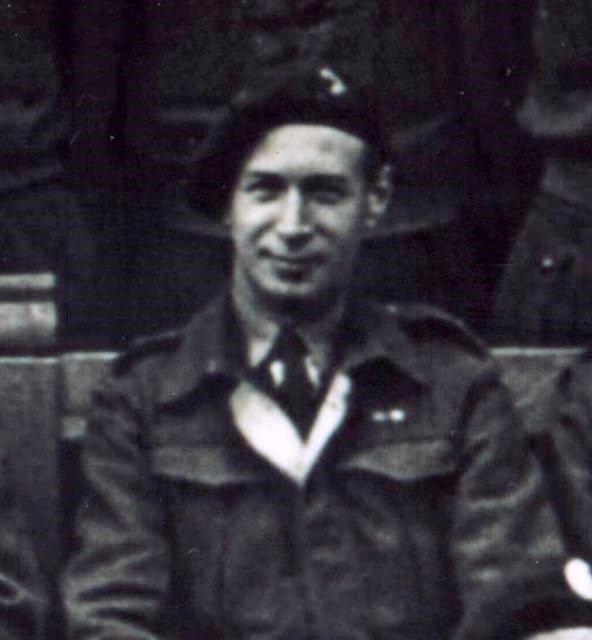
Eric Arnold Kiaer
This story is shared by the Trust with kind permission from John Hamblin, Researcher.
Eric Arnold Kiaer, Lieutenant 130209, Royal Fusiliers (City of London Regiment) and No. 3 Commando. Killed in action on the 6th of June 1944, aged 25.
Eric Arnold Kiaer was born at Hampstead on the 7th of July 1918 the son of Aage Juel Kiaer, a merchant banker, and Karen Margrethe Sofie Kiaer (née Sonne) of London and Copenhagen. He was educated at Mowden School from 1928 to 1932 and at Hurstpierpoint College where he was in Shield House until July 1932.
Following the outbreak of war, he attended an Officer Cadet Training Unit before being commissioned as a 2nd Lieutenant on the General List on the 29th of April 1940. He was promoted to Lieutenant and transferred to the Royal Fusiliers (City of London Regiment) on the 1st of August 1942. He later transferred to No. 1 Commando and served firstly with No. 10 Independent Company and then with No. 2 Independent Company before transferring to No. 4 Independent Company. He was promoted to Lieutenant on the 29th of October 1941.
On the night of the 30th of November 1942 Eric Kiaer boarded a landing craft at the port of Tabaraka in preparation for Operation “Bizerta”, an operation in support of First Army during their advance to capture the port of Bizerta, Tunisia. No. 1 Commando, bolstered by a number of American troops in their midst, were tasked with turning the enemy’s right flank and with cutting their lines of communication. The raiders were split into two groups of five Troops when they landed in deep water at around 1am, some sixty miles up the coast from Tabakara, and waded ashore up to their armpits.
They soon made good progress towards their objectives which were two key road junctions. One of which was on the Tabarka to Bizerta Road. At the junction of the two roads they came under attack from the enemy but held the position for some twenty-four hours before the Germans were driven off. The other junction was held by its defenders for three days with several enemy transports being damaged or destroyed. By the time the two groups retired they had suffered losses of four officers and fifty-six other ranks from the Commandos as well as two officers and seventy-two other ranks among the Americans.
Eric Kiaer, who was a member of Captain Morgan’s Troop, was captured during the fighting and was transported to Italy where he was interned in Prisoner of War Camp PG49 at Fontanellato near Parma. He, and around five hundred others, walked out of the camp at noon on the 9th of September 1943, following the Italian surrender. They made their way south to try to link up with the advancing Allied forces who were fighting their way north. During his six week journey, he travelled some six hundred miles down the spine of the Apennines. During this time, he was recaptured by the Germans and interned in one of their camps but escaped once again after only twelve hours in captivity, before finally crossing the British lines.
For his fortitude, he was recommended by Lord Lovat, Major General R.G. Sturges and by Major General R.E. Laycock for the Military Cross but instead received a mentioned in despatches which was announced in the London Gazette of the 25th of April 1944. The recommendation for his award read as follows: -
"Lieut. Kiaer was serving in No. 1 Commando in North Africa, and was captured on Operation "Bizerta" in December 1943. He was transferred to P.O.W. camp in Italy, from which he escaped in January 1944, but was recaptured. On the signing of the Armistice with Italy, Lieut. Kiaer proceeded on foot towards the British Forces then operating in southern Italy. He covered over 600 miles in 6 weeks, and finally succeeded in crossing the British lines. At one point Lieut. Kiaer was recaptured and placed in a German P.O.W. camp. He remained there 12 hours, during which time he organised 3 escape parties, and then escaped from the camp and proceeded to the British lines. The high courage and fine independence shown by this officer are worthy of the finest traditions of Special Service troops."
On his return to England he was posted to a Commando holding unit at Wrexham before being posted to No. 3 Commando, joining them on the 5th of April 1944.
At 4.30pm on the 5th of June 1944 No. 3 Commando began embarking at Warsash-on-Sea on board LCIs 281, 290, 291, 292 and 293 for the invasion of France. At 7pm that evening they tied up at Stokes Bay before setting sail for the Normandy Coast at 9.30pm. At 8.30am the following morning they were off the Normandy coast where they came under long range sporadic shelling from enemy artillery which proved to be ineffective.
During the long run in to the shore the enemy fire increased and LCI 289 and LCI 290, which contained No. 6 Troop, were hit when they were close to the beach causing a number of casualties, mostly from LCI 290. The surviving LCIs landed on the "Queen Red" sector of Sword Beach at 9.05am. More casualties were sustained as the men advanced up the beach towards their first objective. By midday the unit had fought their way off the beach and assembled at Colville by which time Eric Kiaer had been killed.
Eric Kiaer is buried at Bayeux War Cemetery, Plot X, Row H, Grave 24. He is commemorated on the war memorial at Lancing Prep, Hove and on the memorial at Hurstpierpoint College. His brother, Lieutenant Leslie Herbert Sonne Kiaer, 10th Battalion, Parachute Regiment was killed in action in the Battle of Arnhem on the 20th of September 1944.
FALLEN HEROES
ERIC ARNOLD KIAER
Army • LIEUTENANT
Army Commandos
3 CommandoDIED | 06 June 1944
AGE | 25
SERVICE NO. | 130209
FALLEN HEROES
ERIC ARNOLD KIAER
Army • LIEUTENANT
Army Commandos
3 CommandoDIED | 06 June 1944
AGE | 25
SERVICE NO. | 130209







